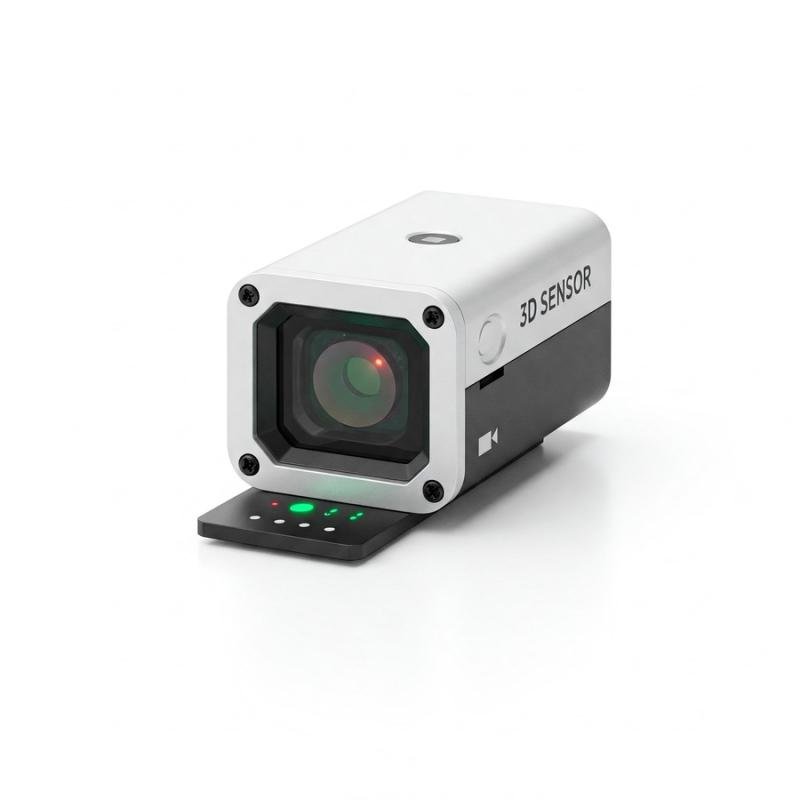The global 3D sensor market is set to redefine industries with breakthrough innovations and rapid expansion. Valued at USD 6.4 billion in 2022, the market is forecast to surge to USD 20.1 billion by 2031, driven by a robust compound annual growth rate (CAGR) of 13.6% from 2023 to 2031. This press release provides an in-depth look at the market’s current landscape, key drivers, major players, recent developments, and future opportunities.
Preview essential insights and takeaways from our Report in this sample – https://www.transparencymarketresearch.com/sample/sample.php?flag=S&rep_id=38018
Market Overview
3D sensors, integral to generating three-dimensional maps of environments, have become indispensable across multiple sectors. These devices leverage various technologies including image processing sensors, time-of-flight (ToF) sensors, structured light systems, ultrasound, and stereo vision to capture data on shape, scale, and distance. Their application spans from object recognition and facial identification to gesture-based control, making them vital in sectors as diverse as consumer electronics, automotive, healthcare, and aerospace & defense.
Recent years have witnessed increased adoption of these sensors, particularly in security and surveillance systems, where high-resolution imaging and real-time scanning are paramount. In addition, the evolution of consumer electronics has spurred a demand for advanced 3D sensors in smartphones, tablets, and other smart devices, further solidifying their market presence.
Market Drivers & Trends
Security and Surveillance Systems:
A significant market driver is the rising need for enhanced security solutions. In both residential and commercial settings, there is a growing trend toward integrating 3D sensor-equipped security cameras. These cameras offer superior features such as position tracking, depth sensing, and gesture recognition, making them ideal for comprehensive surveillance. The integration of LiDAR technology in drones further underscores the importance of these sensors in providing precise 3D mapping for aerospace, defense, and industrial applications.
Consumer Electronics Expansion:
The surge in demand for consumer electronics with advanced features has been a critical trend. Modern devices are increasingly integrating 3D ToF sensors to offer enhanced functionalities like facial recognition, augmented reality, and improved imaging capabilities. Top electronic brands such as Huawei, Samsung, Oppo, LG, and Apple have embedded these sensors in flagship products, thereby broadening the market’s appeal and usage scenarios.
Technological Innovation:
Key players in the 3D sensor market are investing heavily in next-generation 3D sensing hardware. Partnerships and collaborations are fostering the development and rapid commercialization of innovative products. The integration of artificial intelligence (AI) in these sensors is enabling enhanced image processing and decision-making, which in turn drives further adoption across various industries.
Key Players and Industry Leaders
The competitive landscape of the 3D sensor market is characterized by several industry leaders who are continuously innovating to maintain their market edge. Notable companies include:
Infineon Technologies: Pioneering sensor innovations with strategic partnerships to enhance 3D imaging capabilities.
OmniVision Technologies: Recently introduced the OAX4000, an advanced image signal processor designed for automotive and multicamera applications.
Occipital, Inc.: Known for its cutting-edge 3D imaging solutions that serve a variety of industrial and consumer applications.
PMD Technologies AG: Collaborated with Infineon to develop 3D depth-sensing technology for next-generation industrial and medical applications.
Microchip Technology: Delivering robust sensor solutions across diverse industries.
Cognex Corporation and Intel Corporation: Leaders in integrating 3D sensors into industrial robotics and consumer electronics.
IFM Electronic GmbH and LMI Technology: Making significant strides in commercializing efficient and innovative 3D sensor technologies.
Each of these companies has a well-established footprint in the market, characterized by a strong product portfolio, global reach, and continuous investment in research and development.
Recent Developments
The 3D sensor industry is witnessing several pivotal developments that are setting the stage for future innovations:
OmniVision’s OAX4000 Launch: In May 2021, OmniVision Technologies launched the OAX4000 image signal processor. Designed to offer enhanced flexibility in automotive single- and multicamera architectures, this product is tailored to meet evolving market demands by enabling future-proof designs.
Collaborative Innovations: In May 2022, a strategic collaboration between Infineon Technologies and PMD Technologies yielded the IRS2877C Time-of-Flight imager. This breakthrough 3D sensor aids devices like Magic Leap 2 in capturing the physical environment, thereby facilitating advanced industrial and medical applications.
AI-Enabled Advancements: With companies incorporating AI into their sensor designs, products are now capable of more precise image analysis and real-time data processing. These advancements are not only elevating product performance but are also opening up new avenues for market applications.
Visit our report to discover essential insights and analysis – https://www.transparencymarketresearch.com/3d-sensors-market.html
Market Challenges and Opportunities
While the growth trajectory for 3D sensors is promising, the market does face several challenges:
Product Differentiation:
Despite technological advancements, many products in the market lack significant differentiation. This poses a challenge for companies striving to maintain a competitive edge, as similar offerings can lead to price wars and reduced profit margins.
Maintenance Costs:
The high cost of maintenance for advanced 3D sensor systems is another challenge. As these systems become more sophisticated, the associated upkeep and calibration costs can be a barrier, particularly for smaller enterprises or end-users.
Opportunities for Innovation:
The market, however, offers abundant opportunities for those who can overcome these challenges. Continued investment in research and development, particularly in AI and IoT integration, will likely pave the way for more differentiated and cost-effective solutions. Additionally, expanding applications in emerging sectors such as smart cities, autonomous vehicles, and advanced robotics present significant growth potential.
Market Segmentation
To understand the expansive potential of the 3D sensor market, it is segmented based on type, technology, end-use, and region:
By Type:
Image Sensor, Position Sensor, Acoustic Sensor, Proximity Sensor, Others
By Technology:
Stereo Vision, Time-of-Flight (ToF), Structured Sensor, Infrared Sensor Technology, Hall Technology
By End-Use:
Consumer Electronics, Healthcare, Aerospace & Defense, Automotive, Industrial Robotics, Security & Surveillance, Media & Entertainment, Others
This segmentation allows stakeholders to better understand market dynamics, tailor their product offerings, and pinpoint areas of growth based on specific industry needs.
Regional Insights
A detailed analysis of the market reveals that Europe held the largest share in 2022. Several factors contribute to this dominant position:
Research and Development Investments:
European countries have significantly ramped up investments in R&D, particularly in next-generation image-sensing technologies. Government initiatives and funding schemes, such as Horizon Europe-which allocated €95.5 billion for 2021-2027-play a crucial role in driving innovation in the region.
High-Resolution Imaging Demand:
The increasing need for high-resolution cameras equipped with 3D sensors in industries such as automotive, consumer electronics, and security is propelling the market in Europe. This is complemented by the surge in production of smartphones and tablets with advanced imaging capabilities, including low-light photography and optical zoom features.
Expanding Applications:
The integration of advanced 3D sensors in both consumer and industrial applications is fostering market growth. This trend is supported by a strong manufacturing base and a collaborative ecosystem among technology providers across the region.
Future Outlook
Looking ahead, the global 3D sensor market is expected to continue its robust growth trajectory. Key trends that will shape the market include:
Technological Convergence:
The integration of AI, IoT, and advanced sensor technologies will drive the development of smarter, more efficient systems. This convergence will not only enhance product capabilities but also facilitate new applications in emerging fields such as autonomous driving and smart infrastructure.
Expansion in Consumer Electronics:
The proliferation of smart devices with enhanced imaging functionalities will continue to be a major growth driver. As consumer demands evolve, manufacturers are expected to innovate further, resulting in even more sophisticated sensor technologies that deliver higher accuracy and performance.
Increased Collaborative Ventures:
The trend of strategic partnerships and collaborations among key industry players is set to intensify. Such alliances are crucial for accelerating research and development and ensuring rapid commercialization of next-generation 3D sensors.
Global Market Penetration:
While Europe remains a stronghold, significant growth opportunities exist in North America, Asia Pacific, and emerging markets. The expansion into these regions is anticipated to further boost the overall market value, driven by localized innovations and tailored product offerings.
Buy this Premium Research Report for a comprehensive view of market dynamics – https://www.transparencymarketresearch.com/checkout.php?rep_id=38018<ype=S
Frequently Asked Questions
How big was the global 3D sensor market in 2022?
The market was valued at US$ 6.4 billion in 2022.
How is the 3D sensor business expected to grow by 2031?
The market is anticipated to advance at a CAGR of 13.6% from 2023 to 2031, reaching US$ 20.1 billion by the end of the forecast period.
What are the key factors driving the demand for 3D sensors?
The primary drivers include the rising demand for security and surveillance systems, coupled with the expansion of the consumer electronics sector.
Which region held the largest share of the global 3D sensor market in 2022?
Europe was the leading region in 2022, thanks to significant investments in research and development and high demand for advanced imaging solutions.
Who are the prominent manufacturers in the 3D sensor market?
Key players include Infineon Technologies, OmniVision Technologies, Occipital, Inc., PMD Technologies AG, Microchip Technology, Cognex Corporation, Intel Corporation, IFM Electronic GmbH, and LMI Technology.
Explore Latest Research Reports by Transparency Market Research:
Hospital Lights Market: https://www.transparencymarketresearch.com/hospital-lighting-market.html
Structured Cabling Market: https://www.transparencymarketresearch.com/structured-cabling-market.html
About Transparency Market Research
Transparency Market Research, a global market research company registered at Wilmington, Delaware, United States, provides custom research and consulting services. Our exclusive blend of quantitative forecasting and trends analysis provides forward-looking insights for thousands of decision makers. Our experienced team of Analysts, Researchers, and Consultants use proprietary data sources and various tools & techniques to gather and analyses information.
Our data repository is continuously updated and revised by a team of research experts, so that it always reflects the latest trends and information. With a broad research and analysis capability, Transparency Market Research employs rigorous primary and secondary research techniques in developing distinctive data sets and research material for business reports.
Contact:
Transparency Market Research Inc.
CORPORATE HEADQUARTER DOWNTOWN,
1000 N. West Street,
Suite 1200, Wilmington, Delaware 19801 USA
Tel: +1-518-618-1030
USA – Canada Toll Free: 866-552-3453
Website: https://www.transparencymarketresearch.com
Email: sales@transparencymarketresearch.com
This release was published on openPR.














